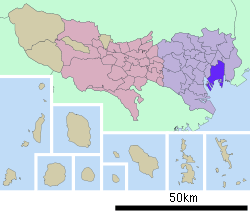Ariake, Tokyo
Ariake (有明) is a district in Kōtō, Tokyo, Japan. It is best known as the region adjacent to and directly east of Odaiba. Ariake is subdivided into four chome and comprises part of the Tokyo Bay Landfill No. 10 and Tokyo Rinkai Satellite City Center. As of April 2012 its population was 6,145.[1]

Ariake is most well known internationally as the site of the Tokyo Big Sight international exhibition centre. Other important facilities located within Ariake include the Differ Ariake Arena, Ariake Tennis Forest Park (Ariake Tenisu no Mori Kōen), Ariake Coliseum, Ariake Sports Center, Massachusetts Mutual Life Insurance Company, Tokyo Ariake University of Medical and Health Sciences, the Japanese Foundation for Cancer Research and the headquarters of Universal Entertainment Corporation. Ariake is a center for shipping in the pulp and paper industry.
The failed Tokyo bid for the 2016 Summer Olympics proposed holding many of its events in Ariake.
Notes
- "江東区の世帯と人口(住民基本台帳による)" [Kōtō-ku households and population (Basic Resident Register)] (PDF) (in Japanese). Kōtō-ku, Civic Affairs Section. 1 April 2014. Archived from the original (PDF) on 23 September 2015. Retrieved 9 January 2015.
Sources
This article incorporates material found in the Japanese Wikipedia in the article 有明 (江東区) (Ariake (Kōtōku)), retrieved on May 2, 2009.
